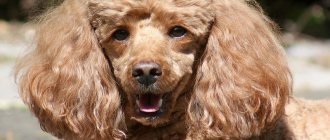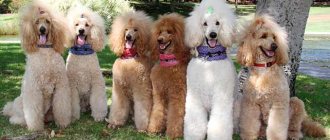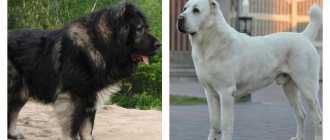- Dog breeds
Poodles are considered one of the smartest breeds in the world. They are highly trainable. Bored poodles can become destructive if left untrained. But active owners who can meet the needs of Poodles will find a lively, intelligent, trainable and the best companion for the whole family.
- Country of origin : France
- Height at the withers : large 45 – 60 cm, small 35 – 45 cm, dwarf 28 – 35 cm, toy 24 – 28 cm
- Weight : large 20 – 30 kg, small 8 – 14 kg, dwarf 6 – 8 kg, toy ~2.5 kg
- Lifespan : 12-15 years
- Use : companion dog, hunting
- Other names : royal poodle (large poodle)
History of the breed
The poodle is one of the oldest breeds that was bred specifically for hunting waterfowl. Most historians agree that the poodle originated in Germany, but the development of this breed was carried out in France.
Many believe that this breed is the result of crossing several European water dogs, including Spanish, Portuguese, French, German, Hungarian and Russian water dogs. Other historians believe that one of the ancestors of the poodle is the North African Barbet, which was introduced to the Iberian Peninsula.
Whatever its origins, it is a very ancient breed. Illustrations of Poodle-like dogs adorn Egyptian and Roman artifacts and tombs dating back to the first centuries BC. e. drawings and statues show dogs that closely resemble modern poodles, fetching game nets, herding animals, and retrieving game from swamps.
Although some say that miniature and miniature poodles appeared soon after the standard, many believe that it was not until the 1400s that breeders began to breed smaller versions of the poodle—first miniatures and then miniatures—to please the Parisian bourgeoisie. The dwarf and miniature varieties were created by crossing small poodles with each other rather than by crossing poodles with smaller breeds.
The French used the larger standard poodle to hunt ducks and the medium-sized miniature poodle to sniff out truffles in the forest. On the other hand, the main job of the miniature poodle was to serve as a companion to the nobility and wealthy merchants. Wealthy owners during the Renaissance often wore their miniature poodles in large, short-sleeved shirts, leading to the nickname “pocket dogs.”
Gypsies and traveling performers learned that poodles were highly trained and were often taken to the circus. They trained poodles to perform tricks, dressing them in costumes to add to their stage appeal. Rich patrons took note of this and began to cut hair and decorate it.
The Kennel Club of England registered its first poodle in 1874, and the first British Poodle Club appeared on the scene two years later.
Performance evaluation and information
- Country : France.
- Size: medium.
- Weight : 8-15 kg.
- Height : from 35 to 45 cm.
- Coat : long, curly or corded.
- Shedding: practically absent.
- Coat color: white, silver, red, black, apricot, black with a blue tint.
- Life expectancy: up to 15 years.
- Litter: average of six puppies.
- Group: decorative.
- Purpose : companion.
- Recognition: CKC, FCI, AKC, UKC, ANKC, NKC, NZKC, APRI, ACR.
- Advantages : high intelligence, excellent learning ability, friendliness, loyalty.
- Disadvantages : Can't stand being alone.
Did you know? In the famous literary work “Faust,” it was in the guise of a black poodle that the tempter Mephistopheles appeared to Doctor Faust. Bulgakov in his work “The Master and Margarita” decorated Woland’s cane with the head of a black poodle. The image of a black poodle, symbolizing Lucifer, appeared on many canvases, for example, in Landseer’s engraving “The Acceptance of the Law.”
Training and education
They are easy to train. Dogs are very inquisitive and smart; during walks they get to know others with interest.
Submitting a dog doesn't always work. The principle of complete submission of the poodle to the owner is an outdated method. This theory was formulated based on observations of packs of wild wolves, but they were kept in captivity and, of course, experienced stress. The stress condition forced wolves to show aggression towards each other, but in the wild they do not show aggression to each other - they live together and interact with each other. You need to perceive yourself as the more experienced and mature member of the pack, who is responsible for guiding the new member (poodle puppy) and teaching him good behavior, as well as correcting him if necessary. It is important to remember that poodle puppies learn a lot on their own. They are very inquisitive, love to explore new territories and, of course, experiment. Puppies tend to repeat actions they enjoy (like playing with a toy). They do not repeat actions that cause them pain (for example, destroying a nest and getting bitten). If your poodle puppy misbehaves, ignore him and praise him when he does the right thing. Reward your puppy for following commands and good behavior. Do not neglect these tips. After all, constantly hearing “you can’t” all day long is unbearable. This is a small child who wants to know everything and get his portion of treats as a reward for not eating your favorite rug, going to the toilet outside, bringing you a ball, and so on.
Set rules and monitor their implementation
It's worth enrolling your poodle puppy in obedience training classes. These classes will allow you to understand exactly what actions will allow you to control your dog’s behavior. You will be able to spend more time with your puppy, establish contact and socialize around other dogs.
Adviсe
- Training a poodle puppy should be done with the help of positive motivation; watch carefully special films about this technique. The Canine Translator film series from National Geographic is suitable.
- If you need to leave your puppy at home alone for 2 hours or more, then ask someone to come to him.
- Be sure to schedule your poodle puppy an appointment with the veterinarian as soon as possible. The doctor will carefully examine him and give him vaccinations that will protect him from dangerous diseases.
Care and maintenance
Content
With its medium size and light weight, the poodle is perfect for both apartment living and private home living.
Walk
Poodles require two walks: morning and evening. Each must be longer than an hour. Play games with your dog and let him run around - this will reduce the need for physical activity.
Nutrition
If you are going to feed your dog food, then choose premium food. With natural feeding you can give:
- cooked meat;
- liver;
- boneless fish;
- eggs;
- cottage cheese;
- porridge;
- fruits;
- vegetables.
It is prohibited to give:
- baking;
- mushrooms;
- legumes;
- sour cream;
- grapes and raisins;
- salty;
- sweet;
- spicy;
- smoked;
- fat;
- roast.
Wool
The coat needs daily brushing. Use brushes with soft bristles made from natural materials. Haircuts are also . The Small Poodle hardly sheds.
Ears, eyes, teeth, claws
The dog's ears are floppy, so you need to pay attention to cleaning them. Eyes are prone to watery eyes; on the advice of a veterinarian, drops should be used. The teeth of small poodles are susceptible to tartar formation. You need to brush it 2-3 times a week and go to the veterinarian regularly for checkups. Nails are trimmed with special tools twice a month, as needed.
Bathing
Small poodles are not the easiest breed to care for precisely because of their coat. Every 2-3 weeks the dog needs to be bathed with a special dog shampoo, then dried with a hairdryer and combed.
Attitude towards children and pets
- Poodles get along well with all family members. Very affectionate and friendly.
- Poodles get along with all pets.
If you decide to get a dog, especially a puppy, then get ready for the following: you will often have to clean up little mistakes after the puppy; investments will be required in annual vaccinations, feeding, toys, ammunition, etc.; Any animal requires attention and communication, so if you don’t have time, then there will be no mutual understanding with your poodle puppy. Big changes are coming in your life. If you can handle this, you will find a loyal friend for life.
Life expectancy and major diseases
In general, poodles live quite a long time - about 12-15 years, which by dog standards is an excellent indicator.
True, the complex of hereditary diseases is quite extensive. First of all this:
- heart disease,
- skin diseases,
- glaucoma,
- Digestive problems.
They are also susceptible to oral diseases - from tartar to inflammation of the tonsils.
Poodles need the same vaccinations as most other breeds.
Character traits
Like all poodles, the small variety is distinguished by its lively and inquisitive disposition. They are very curious and playful, maintaining this attitude until old age. Even older dogs sometimes tend to act like little puppies.
They do not sit still, but are constantly on the move. They love active games and try in every possible way to involve their owners and their family members in them. If there are small children in the house, they will arrange fun games together, but at the same time the dog will be as neat as possible.
Your pet constantly needs long walks and regular exercise. Without them, your pet may start acting up in the house. The owner should take care of this and also come up with fun games for the pet that the pet will use to entertain itself in his absence.
In general, the poodle is a very kind, friendly and intelligent dog breed. Animals are ideal companions that easily adapt to different living conditions.
Similar articles
Caring for a small poodle
Undoubtedly, the main decoration and advantage of the small poodle is its rich coat. For every owner who keeps a representative of this breed, the coat is an indicator of the dog’s class. The Small Poodle breed is characterized by thick, wavy hair, which may also have medicinal properties. The fleece needs careful and attentive care, daily combing. Haircuts are performed at least once every three months. In addition, unkempt, matted fur can cause the animal to become ill. Before sending your dog to the groomer, you need to wash your pet. Shampoo is used no more than once a quarter.
The owner of a small poodle must have at least the basics of grooming so that the area of the muzzle, between the toes and around the genitals is kept in exemplary order. If the dog is sent to exhibitions, grooming occurs once every 2 months, turning to professional groomers. In our constantly developing world, even dog hairstyles are varied, which provides absolute freedom of choice for the owner. As mentioned above, the “lion” hairstyle has still not lost its relevance. Along with it, the owners of representatives of this breed choose “kennel”, “lamb”, “bichon”, “modern” and varieties of these hairstyles.
See also: Shorthaired Pointer (German Pointer)
In addition, you need to monitor what ends up in your pet’s bowl. The food can be either dry food or natural food.
Appearance - standard requirements
The small poodle breed is medium in size - height up to 45 cm, weight no more than 15 kg. The physique is muscular, lean, the length of the body is almost equal to the height at the withers, the withers and croup are also almost on the same line.
The paws are parallel to each other, with well-developed joints and springy pads.
The tail is set high on the line of the loin and looks upward at an oblique angle when moving.
The neck is without dewlap, with a strong scruff and a high-set head.
Muzzle with an elongated nose, length one part less than the length of the head.
The ears are located almost in line with the eyes, according to the standard their length is to the tip of the nose.
The shape of the ears is elongated, rounded at the tips, the ears hang freely, and are covered with hair.
The eyes are located under the frontal lobe, small, almond-shaped, with slight slanting allowed. Eye color ranges from yellow-brown to dark brown.
Wool with a thick undercoat, medium length. Color:
- white;
- cream;
- "coffee with milk";
- apricot;
- red;
- brown;
- ginger;
- silver;
- grey;
- black;
- black and tan;
- White black.
Differences from the Miniature and Royal Poodle
Externally, the subspecies have no differences, the standards of appearance are the same for all, the main difference is in size. In terms of behavioral characteristics, the small poodle differs from the dwarf subspecies of the breed in being more reserved and tolerant; also, unlike dwarf poodles, small poodles can be used as service dogs. There are no differences in temperament and endurance, but medium-sized dogs need less exercise than large specimens and require less space to keep. Unlike the royal poodle, the small poodle is less susceptible to diseases of the musculoskeletal system.











